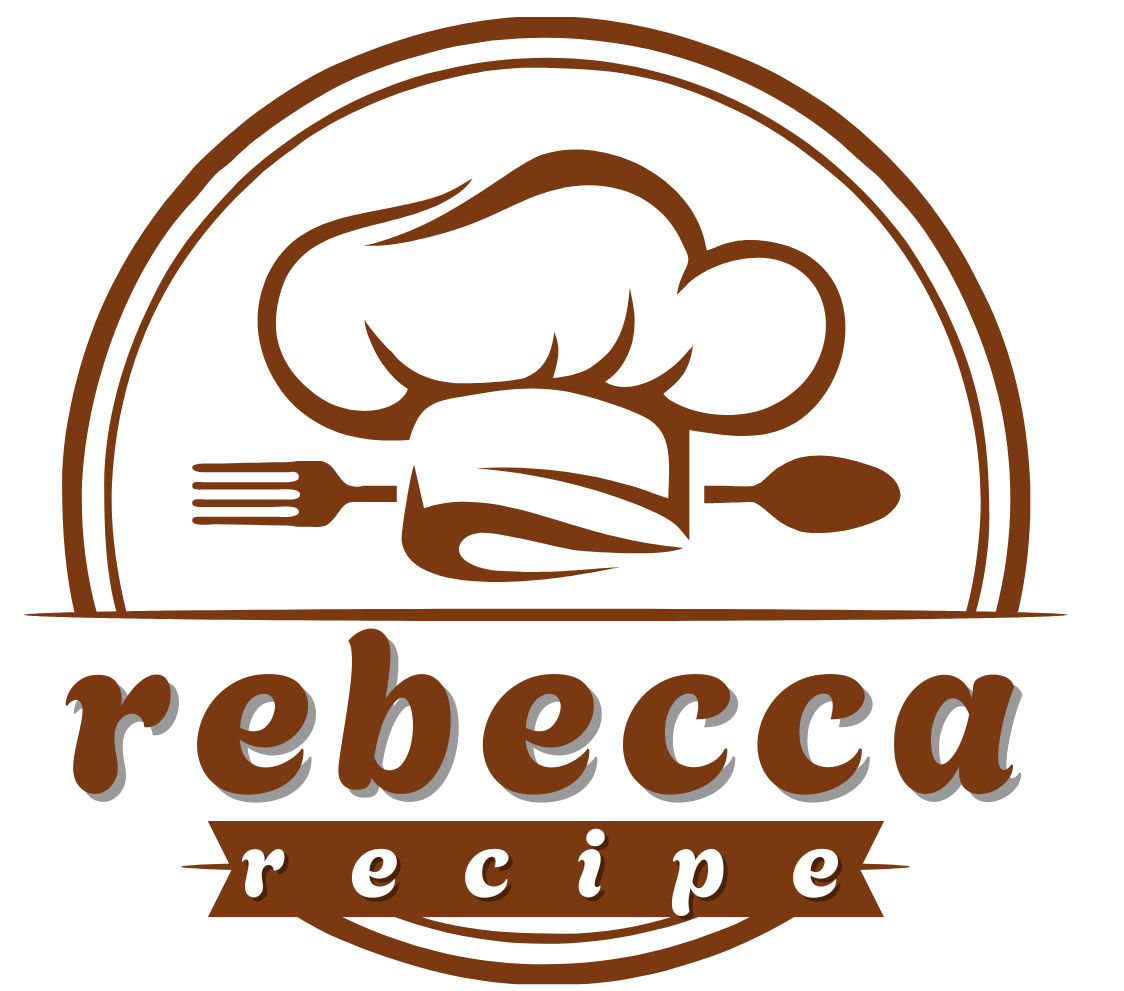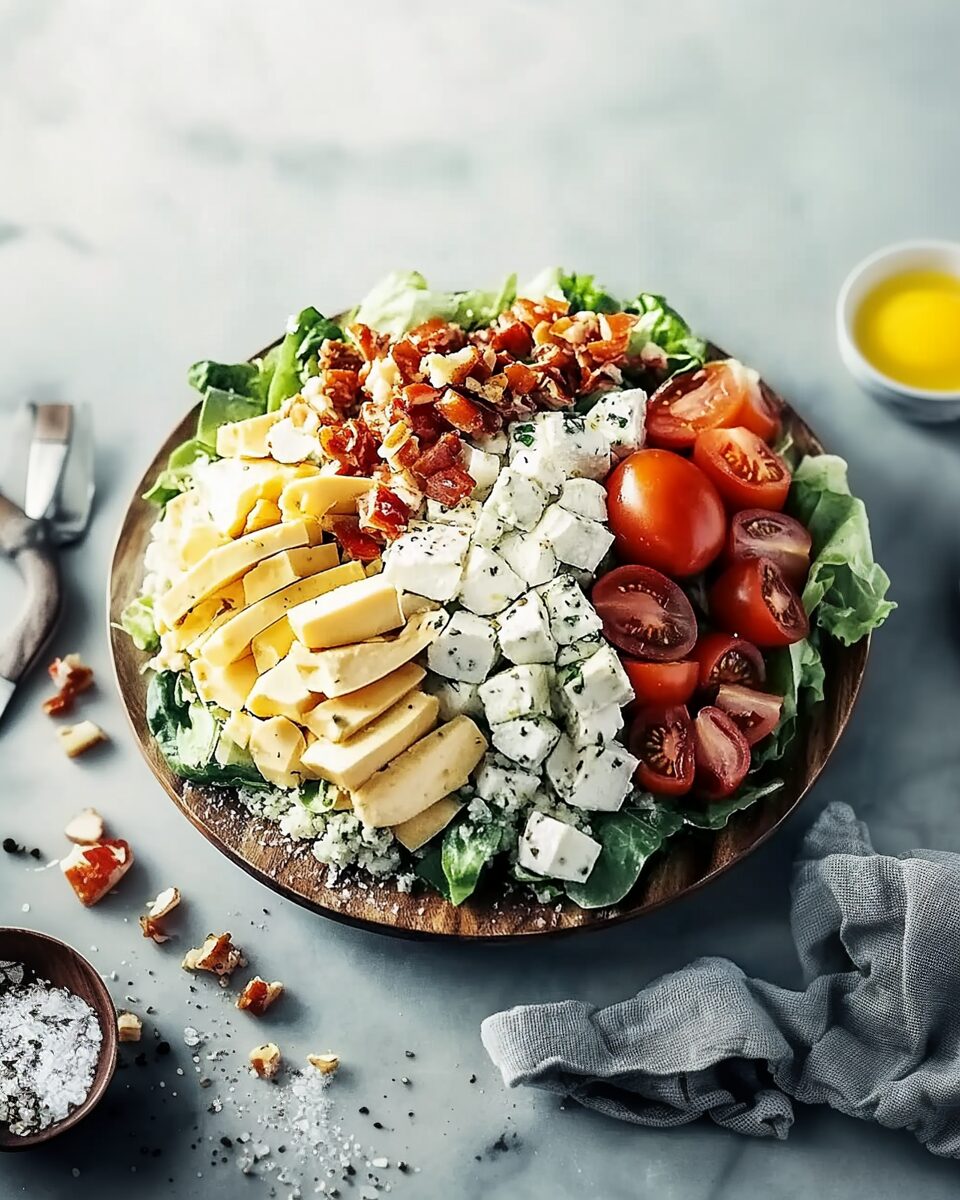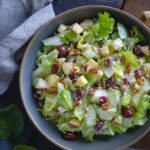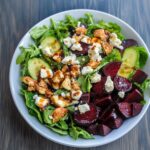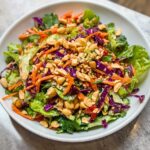The Cobb Salad is a quintessential American dish that has stood the test of time. Originating in the 1930s at Hollywood’s Brown Derby restaurant, it was created by owner Bob Cobb as a late-night snack using ingredients he had on hand. Today, the Cobb Salad is celebrated for its vibrant colors, rich flavors, and satisfying combination of ingredients. This traditional version features a bed of mixed leafy greens topped with grilled chicken, crispy bacon, hard-boiled eggs, tomatoes, avocado, and blue cheese, all drizzled with a classic vinaigrette dressing.
Full Recipe:
Ingredients
- Romaine lettuce
- Chicory
- Watercress
- Grilled chicken breast, diced
- Crispy bacon, crumbled
- Hard-boiled eggs, sliced
- Cherry tomatoes, halved
- Avocado, diced
- Blue cheese, crumbled
- Classic vinaigrette dressing
Directions
- Wash and dry the romaine lettuce, chicory, and watercress thoroughly.
- In a large salad bowl, combine the prepared greens.
- Arrange the diced grilled chicken, crumbled bacon, sliced hard-boiled eggs, halved cherry tomatoes, diced avocado, and crumbled blue cheese in rows over the greens.
- Drizzle with the classic vinaigrette dressing just before serving.
- Toss gently to combine and enjoy immediately.
Nutritional Facts
Note: Nutritional information is approximate and may vary based on specific ingredient brands and quantities used.
- Calories: Approximately 450-500 kcal per serving
- Protein: 30-35g
- Total Fat: 30-35g
- Saturated Fat: 7-10g
- Cholesterol: 150-200mg
- Carbohydrates: 15-20g
- Fiber: 5-7g
- Sugars: 5-7g
- Sodium: 600-800mg
A Brief History of the Cobb Salad
The origin story of the Cobb Salad adds a charming anecdote to its appeal. It’s widely believed that the salad was created by Bob Cobb, the owner of the famous Brown Derby restaurant in Hollywood. As the tale goes, Bob concocted the salad late one night using ingredients he found in the restaurant’s kitchen—lettuce, avocado, tomatoes, chicken, hard-boiled eggs, cheese, and crispy bacon. He tossed everything together with a vinaigrette dressing and served it to Sid Grauman, a frequent customer and owner of the Grauman’s Chinese Theatre. Grauman loved it so much that the salad was added to the menu, and its popularity quickly skyrocketed.
What began as a spontaneous creation became a beloved dish known for its visual appeal, satisfying taste, and hearty nutrition. The Cobb Salad is now considered a classic American dish, often imitated and personalized but always rooted in the same foundational principles.
The Anatomy of a Cobb Salad
What makes a Cobb Salad so unique is its signature arrangement. Instead of tossing all the components together, the toppings are traditionally laid out in neat rows across a bed of greens, creating a stunning presentation. This allows each ingredient to stand out while offering a customizable eating experience. Diners can mix everything up or eat each element separately, depending on their preference.
The traditional salad typically includes grilled chicken, crispy bacon, hard-boiled eggs, avocado, tomatoes, and blue cheese crumbles served atop romaine lettuce, chicory, and watercress. The dressing is usually a red wine vinaigrette, although many modern variations include ranch, blue cheese, or balsamic.
What makes the Cobb Salad particularly appealing is that it offers a full spectrum of flavors and textures: the crispiness of the bacon, the creaminess of the avocado, the sharpness of the blue cheese, and the refreshing crunch of the greens. It’s a dish that delivers both comfort and complexity.
Cultural and Culinary Significance
The Cobb Salad is a testament to how American cuisine can be both creative and practical. At its core, it’s a “kitchen sink” meal—something you can make by pulling together what’s available in your fridge—but it’s elevated through thoughtful combinations and preparation. It reflects a culinary tradition that values flavor, convenience, and nourishment.
Beyond its roots in Hollywood glamor, the Cobb Salad symbolizes the way food trends travel and evolve. Over the decades, its popularity has endured not only in the United States but also in other parts of the world. Restaurants and home chefs have embraced it for its versatility, often modifying the ingredients to cater to dietary restrictions or cultural tastes.
Today, Cobb Salad appears in countless cookbooks, food blogs, and restaurant menus, often with slight alterations to cater to health trends, like using turkey bacon instead of pork or substituting grilled tofu for chicken to make it vegetarian. Despite these tweaks, the spirit of the dish remains intact—bold, hearty, and delicious.
Health Benefits of Cobb Salad
One of the main reasons for the Cobb Salad’s lasting popularity is its impressive nutritional profile. When made with quality ingredients and minimal processed additions, it can be a highly nutritious meal that provides a wide range of health benefits:
-
High in Protein: The inclusion of grilled chicken, hard-boiled eggs, and bacon provides a generous protein boost, which is essential for muscle repair, immune function, and overall energy.
-
Healthy Fats: Avocado and olive oil (from the vinaigrette) offer heart-healthy monounsaturated fats that help reduce bad cholesterol levels and support brain health.
-
Fiber-Rich Greens: The leafy greens, especially watercress and romaine, are rich in dietary fiber, aiding in digestion and promoting a feeling of fullness.
-
Vitamins and Minerals: Each ingredient brings its own nutritional perks—avocados are rich in potassium and folate, eggs contain B vitamins and choline, and tomatoes provide antioxidants like lycopene.
-
Low Carb Option: With no added sugars or refined carbs, Cobb Salad fits well into low-carb or ketogenic diets when prepared traditionally.
For those aiming to eat cleaner or follow specific health regimens, the Cobb Salad offers flexibility and peace of mind. It can be tailored to suit keto, paleo, gluten-free, and even dairy-free lifestyles.
Modern Twists and Variations
While the original Cobb Salad has a time-honored formula, it’s also a canvas for creativity. Here are some modern adaptations that reflect today’s diverse dietary preferences and global tastes:
-
Vegetarian Cobb Salad: Replace chicken and bacon with grilled tempeh, chickpeas, or roasted mushrooms for a plant-based twist.
-
Mediterranean Cobb: Incorporate ingredients like olives, feta cheese, cucumber, and a lemon-herb vinaigrette for a Mediterranean flair.
-
Southwest Cobb: Add corn, black beans, pepper jack cheese, and a chipotle-lime dressing to give the salad a Tex-Mex vibe.
-
Seafood Cobb: Substitute chicken with grilled shrimp, salmon, or tuna for a pescatarian-friendly version.
-
Vegan Cobb: Use tofu or plant-based meat alternatives, dairy-free cheese, and egg substitutes to make a completely vegan salad without sacrificing taste.
Each of these variations retains the layered, bold nature of the original Cobb while introducing new flavor profiles. That’s part of the magic—no matter how it’s customized, the Cobb Salad still feels like a satisfying, complete meal.
The Role of Presentation in the Cobb Salad
Another defining feature of Cobb Salad is its visual appeal. Unlike most tossed salads, which can appear haphazard, the Cobb is meticulously assembled. Each ingredient is laid out in distinct rows or sections over the greens, making it an Instagram-worthy dish long before social media existed.
This arrangement also makes the salad feel more indulgent. By showcasing the individual elements, the dish honors the freshness and quality of each component. It transforms a simple salad into a composed, chef-like experience that elevates everyday dining.
Presentation matters not only for aesthetics but also for the psychological satisfaction it brings to the table. Diners tend to enjoy meals more when they look as good as they taste—and the Cobb Salad delivers on both fronts.
The Cobb Salad as a Meal Prep Star
Thanks to its balance of macronutrients and its hearty ingredients, Cobb Salad is a favorite among those who meal prep. It holds up well in the fridge and can be portioned into containers for a week of quick, healthy lunches or dinners.
To meal prep a Cobb Salad:
-
Store the dressing separately to avoid soggy greens.
-
Keep wet ingredients like tomatoes and avocados in separate compartments or add them fresh.
-
Use sturdy greens like romaine or kale for longer shelf life.
The meal-prep potential of Cobb Salad adds to its modern appeal. It’s a way to enjoy gourmet-style meals even on your busiest days, all while staying nourished and satisfied.
Conclusion
The Cobb Salad is a shining example of how simplicity, balance, and versatility can come together to create a truly exceptional dish. With its origins rooted in the golden age of Hollywood and its place secured in the annals of American culinary tradition, it’s much more than just a salad—it’s a cultural icon.
